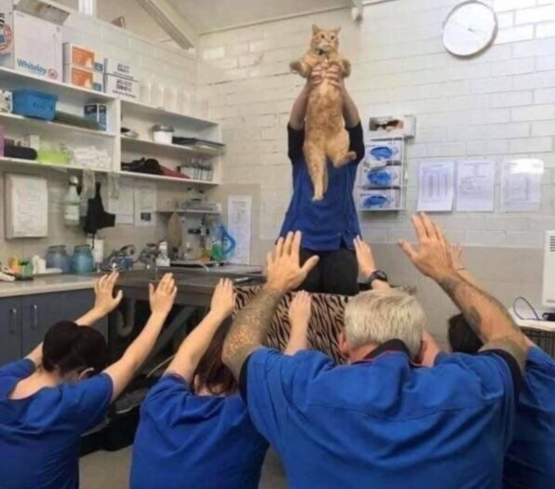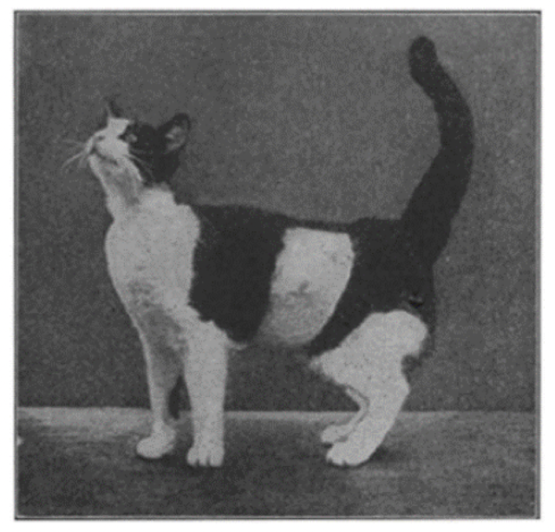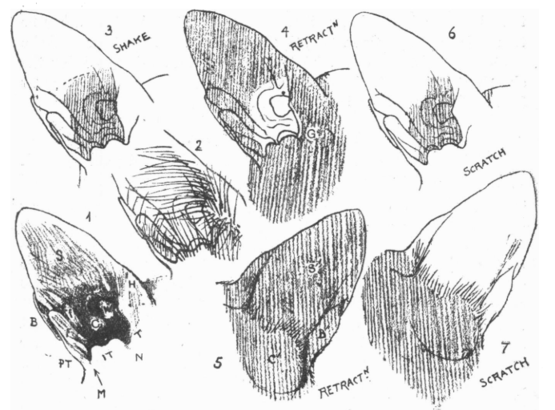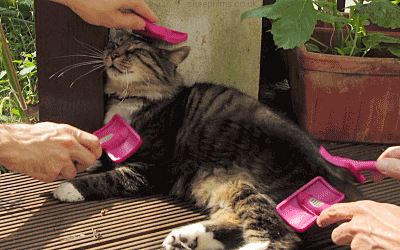In the field of life science and medical research, animal experiments are the only way to go through many studies. People are used to using “guinea pig” to refer to the experimental animals used in scientific research, but the experimental animals are not only mice, but also nematodes, zebrafish, fruit flies, naked mole rats, rabbits, dogs, monkeys, and—
Our dear cats.

Yes, this cute little animal with a large number of “Cat Cat Cult” followers has another identity: a certified experimental animal.
Now, let’s understand some of the stories of cats and cats behind the Nobel Prize.
1912: The cat who underwent a kidney transplant
The origins of cats and the Nobel Prize can be traced back to 1912.
That year, French physician Alexis Carrel was awarded the Nobel Prize in Physiology or Medicine for his work on three-point vascular anastomosis and organ transplantation . Carrel was later criticized for his political beliefs, but for his outstanding achievements at a young age, he was still called the “father of organ transplantation”, and this title was mentioned along with a series of his work on various animals. Organ transplantation experiments.
Perhaps the most widely circulated story about Carrell is that he successfully transplanted two kidneys from one dog into another dog that had previously had a kidney transplant. In fact, he also successfully performed double-kidney transplants on cats, and in 1908, he performed the first successful single-kidney transplants on cats, which proved that a single-kidney transplant can maintain normal life activities .  The cat who has undergone kidney transplant surgery, this is what it looked like 21 days after the operation, when it was filmed, it was looking at a piece of meat丨Reference [1]
The cat who has undergone kidney transplant surgery, this is what it looked like 21 days after the operation, when it was filmed, it was looking at a piece of meat丨Reference [1]
A cat who has undergone a kidney transplant, this is what it looked like 21 days after the operation, when it was filmed, it was looking at a piece of meat | Reference [1]
Flip through Carrell’s papers published in 1906-1908, and you can see extensive records of cat kidney transplants:
Experiment 9.—October 14, 1907 Preparing the host: Grey-white female cat, living in laboratory for several months; young and in good health.
On October 1st, urine was checked – yellow, clear, density 1.039, urea 5.9 g/ml, no albumin. Open the abdomen and internal organs as usual. The intestinal tract is protected with a sterilized Japanese silk towel coated with petroleum jelly. Dissection and removal of both kidneys: Ovarian vein, inferior superior renal vein, and two aortic collaterals were ligated. … October 15 The cat was a little sick, drinking water, and walking around in its cage. From 4 p.m. yesterday to now, there is only 25 ml of urine, dark yellow, with a little blood and albumin, density 1.051. On October 16, the cat has improved, drinking milk and eating a little meat, the urine output is 16 ml. On October 17th, I was in good shape, drinking milk and eating meat. On October 18, the same as on October 21, the cat has fully recovered, and it is a normal cat as before the operation. …Nov 7 the cat was a little depressed and walked around in its cage. The cat looked fine in the morning of November 14, but at night it looked sick, making noises in its nose and refusing to eat. Nov 18 The cat was very weak and died at 11pm on Nov 19.
Thanks to Karel’s proof that ” after removing both kidneys, transplanting only one kidney can save lives “, people realized that donors only need to donate half of the kidneys to save lives, which is also for later living kidneys Transplantation laid the groundwork.
Over the ensuing decades, as technology developed, finally in 1954, doctors John P. Merrill and David Hume of Harvard University in the United States successfully conducted a In the first living organ transplant, one side of the kidney of the identical twin brother was successfully donated to his brother who suffered from uremia. In this way, the brother’s life lasted for eight more years, and the brother who lost one kidney also Enron lived to be 79 years old.
For people at that time, uremia was a terminal disease that was no different from a tumor, and the five-year survival rate was not high. The success of living-donor kidney transplantation has undoubtedly brought hope of survival to patients.
1932: The Cat’s Classroom
At the same time that Carrell’s cat received an organ transplant, neurophysiologist Charles S. Sherrington was using cats to explore neural reflexes and proprioception, research that earned him the Nobel Prize in 1932 Physiology or Medicine Award.
Sherington was always surrounded by cats during his tenure at Oxford University. He teaches a course related to mammals. There are usually five or six cats in the class as teaching tools, and his laboratory is called ” cat class “ by students because of the experimental cats everywhere.
In 1898, Sherrington found that if the cat’s brainstem was transected between the superior and inferior colliculus of the midbrain, the cat would appear rigid, such as the head and tail raised, the spine stiff, and the limbs straight. This phenomenon, called decerebrate rigidity , is caused by excessive tension in the extensor muscles (also known as antigravity muscles, the muscles that straighten the limbs or other parts of the body when they contract). On this basis, Sherrington discovered the stretch reflex , which is the reflex that occurs when the muscles are overstretched.  a. Cats in the catenary state; b. The cat’s left front foot is stimulated in the decerebral state; c. The cat’s left hind paw is stimulated in the catenary state.丨 References [3]
a. Cats in the catenary state; b. The cat’s left front foot is stimulated in the decerebral state; c. The cat’s left hind paw is stimulated in the catenary state.丨 References [3]
How cats stand and “walk the catwalk” also intrigued Sherrington. In 1910, Sherrington described a phenomenon in which cats could stand even after their brains were removed, and they could walk in regular alternating movements. Therefore, he believes that the standing and regular walking of animals are triggered by the sensory stimuli generated by the lower limbs on the ground. The “standing reflex” or “stepping reflex” triggered by the sensory stimuli does not require the participation of the brain, but directly passes through the spinal cord. This brings people’s understanding of sports a step further .  Removal of a standing cat from the brain丨Reference [4]
Removal of a standing cat from the brain丨Reference [4]
In 1917, Sherrington focused his attention on the cat’s auricle and the reflexes it can make . He defined and studied various reflexes of the cat’s ear in detail, including retraction reflex, folding reflex, covering reflex, Itching reflex and shaking head reflex, and proved that these reflexes do not require the participation of the brain. In the paper, he wrote:
“The cat’s auricle is sensitive and flexible, and produces many reflexes. One of them I briefly mentioned in previous research, and I know other people haven’t paid attention to them, although there is no doubt that they must have been encountered by other observers. .”  Hand-painted cat ears in Sherrington’s paper丨References [5]
Hand-painted cat ears in Sherrington’s paper丨References [5]
At the same time, he also found that, without the involvement of the brain, cats can make reflexes such as tail tip wagging or hair erection in the face of dog barking, cat meowing and birdsong. These studies of various forms of reflexes, such as cat ears and tail wagging, have led to the realization that there are far more types of neural reflexes than thought.
1981: True Cat with a Blindfold
If one were to choose a mascot for the 1981 Nobel Prize ceremony, cats might be the most appropriate, because that year’s Nobel Prize in Physiology or Medicine was awarded to scientists from two teams, and both teams chose the same Experiment with cats. They were Roger W. Sperry, who discovered the functional specialization of the cerebral hemispheres, and David H. Hubel and Thorstein Witzel, who figured out information processing in the visual system. (Torsten N. Wiesel).
In Sperry’s time, it was anatomically found that the left and right brains were connected by a bundle of fibers, which were flat in shape and about 10 cm long and named the ” corpus callosum “. But people at that time only knew that the “corpus callosum” connected the left and right brains in structure, but did not know its specific function in function. So Sperry wanted to try cutting the corpus callosum to see if it could transmit information from both hemispheres of the brain.
He chose visual signals as the information that the brain needs to receive, so that it is convenient to cover one eye to achieve signal input from one hemisphere of the brain.
In a study published in 1953, Sperry put light-shielding blindfolds on cats whose corpus callosum was cut and taught them to distinguish between squares and circles. He first had the cat cover its left eye and use its right eye to learn to distinguish different shapes, and then switch it over, cover its right eye, and let the cat learn to distinguish the exact same shape with its left eye.
It was found that in the case of normal information transfer between the brains, the second learning is more intensive than the first learning content, so the acquisition rate will be faster than the first learning. However, for the kitten whose corpus callosum was cut off, the knowledge learned with the right eye was still completely unfamiliar to the second learning with the left eye, which indicated that after the corpus callosum was cut off, the two cerebral hemispheres could not transmit information .  The blindfolded cat needs to distinguish several sets of different shapes with the other eye丨Reference [6]
The blindfolded cat needs to distinguish several sets of different shapes with the other eye丨Reference [6]
After confirming that the corpus callosum is the bridge for the information exchange between the two hemispheres of the brain, Sperry was keenly aware that patients who had their corpus callosum cut off for the treatment of epilepsy were undoubtedly the best subjects for research on left and right brain function. As a result, Sperry became a leader in the field of cognitive neuroscience and played an indispensable role in the development of brain science.
Huber and Wizel are also keen to study the cat’s eyes, because the cat’s snout is shorter and more similar to the flat facial structure of humans, and it is easier to design a partitioned field of vision when doing vision-related experiments. Compared with the size of the skull, the cat’s eye socket is relatively large, and the visual system is relatively complete, which is convenient for research.
During their 25-year collaboration, Huber and Witzel have advanced the search for neural mechanisms of vision . They developed a method that can measure the activity of a single cell in the visual cortex, then show the cat light bands of different directions and wavelengths, and use microelectrodes to measure the potential changes of visual neurons to identify different types of visual neurons . It turned out that some cells in the cat’s primary visual cortex are very sensitive to the direction of light, while others are sensitive to the wavelength of light.  The cat looking at the light belt in the experiment丨Reference [7]
The cat looking at the light belt in the experiment丨Reference [7]
In addition, they also studied the impact of monocular visual deprivation on the visual cortex during visual development by suturing the eyelids of kittens, and found that visual coding is only formed after birth, and requires a necessary factor, which is “visual stimulation”. During the prime time of visual development, the visual cortex undergoes permanent functional changes as long as the eyes are closed for a few days. From this, they put forward the concept of ” critical period ” of optic nerve development.
On this basis, more researches later proved that not only vision needs stimulation of external information in the early stage of development, but also hearing, language acquisition and motor function. At the same time, the concept of the critical period of neurodevelopment has also opened a new door for understanding and treating cataracts and strabismus in children. If we can grasp the critical period of visual development and carry out surgical treatment and vision correction for children, many children can avoid Lifelong low vision or blindness.
In fact, in scientific research ( not just the research that won the Nobel Prize ), there are many stories about cats, some of which are closely related to human health, such as the physiology of the pancreas and liver, the discovery of acetylcholine, and the development of antidepressant drugs. Wait… there are cats.
Let’s say: thank you cat cat.

Figure丨Giphy.com
The 2022 Nobel Prizes will be announced one after another from October 3 . This year, Nutshell will still wait for the results of the Nobel Prize with you, and we will release the most reliable interpretation of the Nobel Prize as soon as possible.
Come and pay attention, don’t miss it!
Click on the picture to enter the collection of Nobel Prize interpretations over the years
references
[1] Carrel, A., Transplantation in Mass of the Kidneys. J Exp Med, 1908. 10(1): p. 98-140.
[2] Ebeling, AH and A. Carrel, Remote Results of Complete Homotransplantation of the Cornea. J Exp Med, 1921. 34(5): p. 435-40.
[3] Sherrington, CS, Decerebrate Rigidity, and Reflex Coordination of Movements. J Physiol, 1898. 22(4): p. 319-32.
[4] Sherrington, CS, Flexion-reflex of the limb, crossed extension-reflex, and reflex stepping and standing. J Physiol, 1910. 40(1-2): p. 28-121.
[5] Sherrington, CS, Reflexes elicitable in the cat from pinna vibrissae and jaws. J Physiol, 1917. 51(6): p. 404-31.
[6]Myers, RE, Interocular transfer of pattern discrimination in cats following section of crossed optic fibers. J Comp Physiol Psychol, 1955. 48(6): p. 470-3.
[7] Hubel, DH, Single unit activity in lateral geniculate body and optic tract of unrestrained cats. J Physiol, 1960. 150: p. 91-104.
Author: A Hardy
Editor: Malt Young
Source of cover image: imgflip.com
an AI

Figure丨Giphy.com
This article is from Nutshell and may not be reproduced without authorization.
If necessary, please contact [email protected]

This article is reproduced from: http://www.guokr.com/article/462330/
This site is for inclusion only, and the copyright belongs to the original author.

